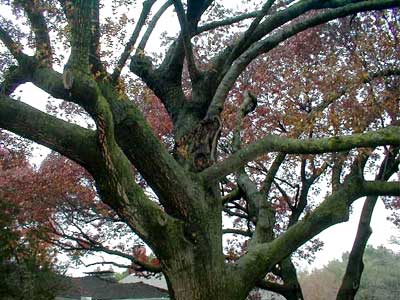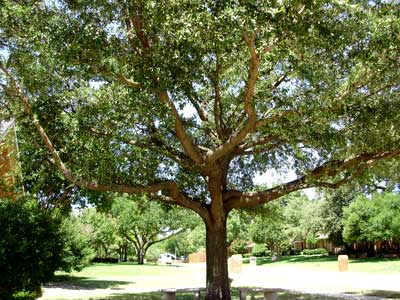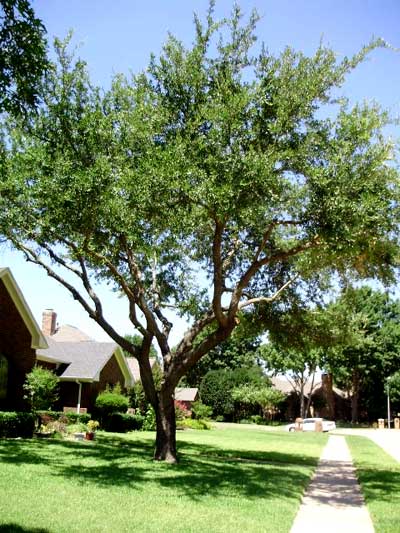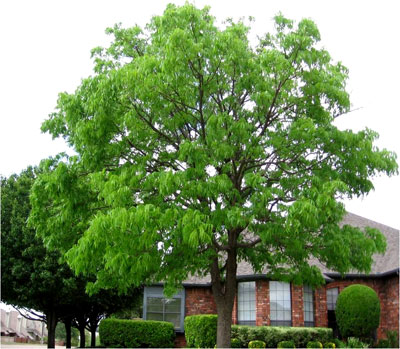Texas Tree Tips – July, 2012
Foliage Keeps Your Tree Healthy and Wealthy — So Be Wise
A tree’s foliage has the crucial task of using sunlight and the process of photosynthesis to produce the tree’s “food.” As a result, tree care industry standards state that no more than 25 to 30 percent of a tree’s foliage should be removed in a given year. When properly pruned, most tree species would require this amount of foliage removed only every two to four years. Excessive removal of foliage diminishes a tree’s health and its food production capacity, much the same as an excessive reduction in a person’s diet can affect that individual’s health. Repeated removal of large amounts of foliage can cause a decline in tree health, or even worse — the death of a tree.
When too much foliage is removed from the upper canopy of a tree, excessive exposure of bark tissue to the sun can result in “sunscald” or damage to the bark and the underlying vascular system. Smooth-barked trees are more susceptible to sun injury, which further reduces a tree’s health and longevity.

Excessive pruning exposed the interior of this red oak to the hot summer sun. The resulting sunscald damaged the bark tissue and underlying vascular system, diminishing the tree’s health. All photos courtesy of Steve Houser.
Excessive pruning also causes an inordinate amount of interior or epicormic sprouts, and diminished growth at the tips of the limbs. Excessive sprouting requires constant pruning to maintain the aesthetic qualities of a tree, greatly increasing the cost of ongoing maintenance.

Interior sprouts are an indicator of recent excessive pruning. Pruning to remove interior sprouts becomes a high-maintenance practice that can be avoided altogether with proper pruning practices.
Research shows that removing all interior growth out to the ends of a limb, leaving only a tuft of foliage on the tips, significantly increases the likelihood that the branch will break. The tree becomes more vulnerable to winds, ice, and snow. This pruning practice is referred to as “lion-tailing,” or “gutting,” and is counter to our industry’s standards. On a personal note, I have shed a few tears over the years as I have watched many favorite old trees with magnificent grandeur, suffer from this fate as, over time, they slowly fell apart. Gutting is falsely justified to get more sunlight to the underlying turf at the expense of priceless and irreplaceable trees. Tree health and longevity should not be sacrificed for a green lawn.

“Gutting,” or “lion-tailing,” is a form of excessive pruning that often results in a tree being highly susceptible to storm damage.
From a distance, a properly pruned tree does not look pruned. The foliage density is evenly distributed throughout the tree’s canopy.

Properly pruned trees retain evenly distributed foliage throughout the canopy.
As trees grow larger, they require less maintenance and a smaller maintenance budget, if the landscape plantings under tree canopies are modified or adapted to the shadier conditions. With appropriate modifications, the trees and plants in your landscape will be much healthier, provide more benefits for a longer period of time, and save you dinero in the long term. True to the laws of nature, landscapes and ecosystems will always be in constant change. As a result, the best landscapes and ecosystems work within the boundaries of nature, rather than pushing them to the limits of a tree’s physical and biological capacity. Proper pruning honors those boundaries.
About the author: Steve Houser is a Dallas native with more than 30 years of experience as a consulting arborist and tree climber. He is the president of Arborilogical Services Inc., “The Experts Your Trees Deserve.” www.arborilogical.com.

